Today we report in Nature Chemistry a novel approach to designing protein fibers that takes inspiration from silk, wool, and spider webs. This research opens up new avenues in textiles, bioengineering, and beyond.
“Silk, wool, and spider webs are all examples of natural protein fibers, and each has a unique blend of flexibility, strength, and biodegradability. Our work shows that it is now possible to create brand new, sophisticated protein fibers with custom properties,” says lead author Neville Bethel, PhD, a postdoctoral scholar in the Baker Lab and HHMI Hanna Gray Fellow.

The team used ProteinMPNN, a powerful machine-learning algorithm for protein sequence design, to create dozens of new fibrous proteins. When constructing the fibers, the team drew inspiration from DNA’s famous double helix structure. Just as the two strands of a DNA molecule wind around one another, the proteins that make up the new fibers were made to twist into three-, four-, five- and six-stranded structures. This sophisticated control at the molecular level is difficult to achieve and was made possible by the use of advanced molecular design software, including ProteinMPNN.
In collaboration with the IPD Core Research Labs, we confirmed that the thicknesses, lengths, and nano-scale features of the fibers closely matched the design models. X-ray crystallography and single particle cryo-electron microscopy were used to build atomic-resolution structures for numerous designs. Because the fibers were created from scratch, we were able to produce a range of material properties such as stiffness and porosity.
These initial results offer a glimpse into a future where new biomaterials are designed at the molecular level to meet specific challenges. “We’ve succeeded in producing these fibers at low costs using bacteria, but more work still needs to be done to ensure that these new molecules can be grown at scale,” adds Bethel.
“Whether it’s medical implants, environmental solutions, textile innovations, or bioelectronics, we’re looking at a future where materials can be engineered at the molecular level to solve complex challenges,” concludes senior author David Baker.
Funding
The team included scientists from the University of Washington, the University of Bristol, and the Lawrence Berkeley Laboratory.
This research was supported by the Howard Hughes Medical Institute (GT11817), the Donald and Jo Anne Petersen Endowment for Accelerating Advancements in Alzheimer’s Disease Research, the Audacious Project at the Institute for Protein Design, the Bill & Melinda Gates Foundation (INV-010680), the Engineering and Physical Sciences Research Council (EP/S017542/1), and a BrisSynBio grant (BB/L01386X/1). Crystallographic data was collected at the Advanced Light Source (ALS) and Advanced Photon Source (APS). ALS is a national user facility operated by Lawrence Berkeley National Laboratory on behalf of the Department of Energy. At APS, the Northeastern Collaborative Access Team beamlines are funded by the National Institute of General Medical Sciences from the National Institutes of Health (P30 GM124165). Additional support came from the National Institute of Health project ALS-ENABLE (P30 GM124169) and a High-End Instrumentation Grant (S10OD018483).
